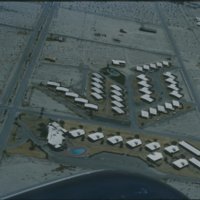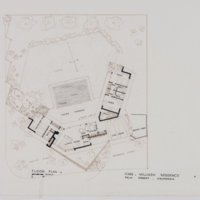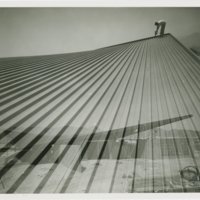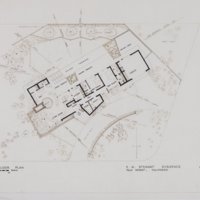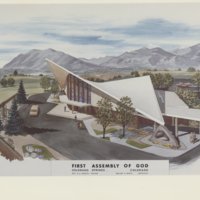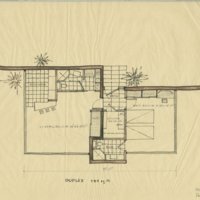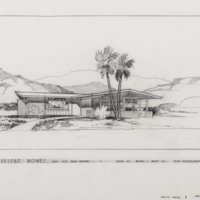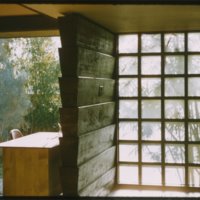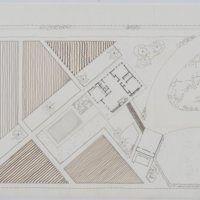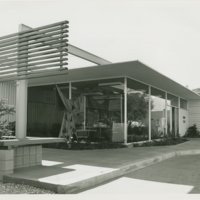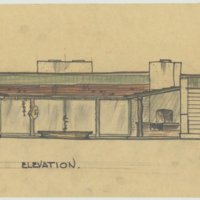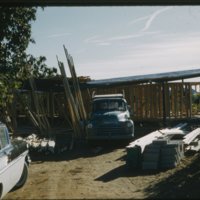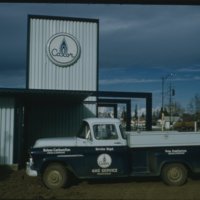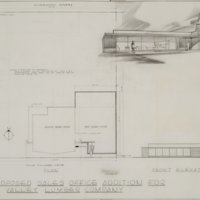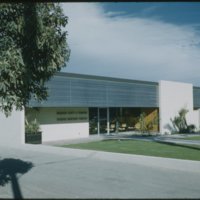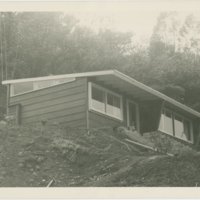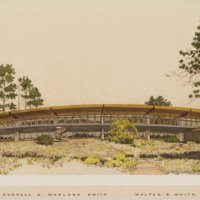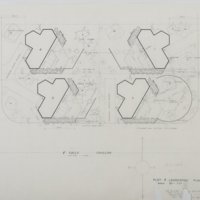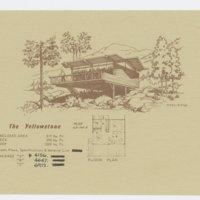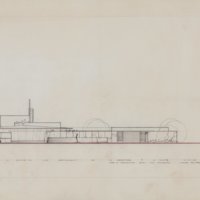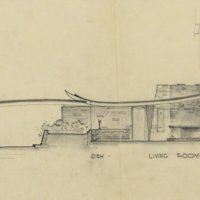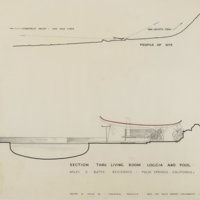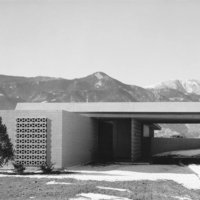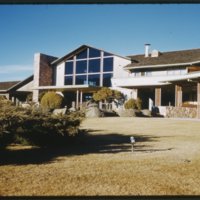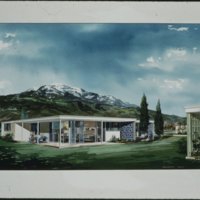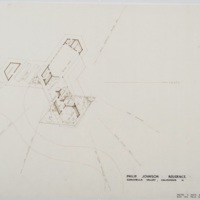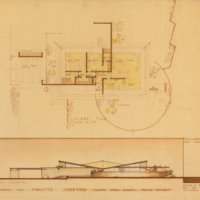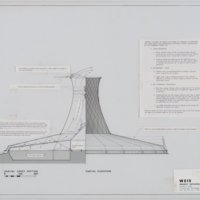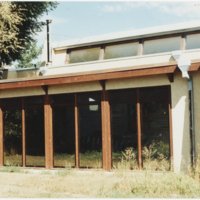Walter S. White (1917-2002)
Description
Walter S. White was born in 1917. Between 1933 and 1936 he attended San Bernardino High School. White worked for six months in 1937 for Harwell H. Harris followed by an eight month term in Rudolf Schindler’s Los Angeles office during 1937-1938. After working with Schindler White worked for Allen Rouff for six months between 1938 and 1939. Between 1939 and 1942, White worked for Win E. Wilson for two years and six months, helping to plan and design prefabricated war housing with a skin-stressed plywood panel system. In his papers White recounts that over 8,000 of these units were constructed in the United States.
For the remainder of the war, White was employed by the Douglass Aircraft Co. in El Segundo, California, working on machine tool design for four years and six months, 1942 to 1946. In 1947 White moved from Los Angeles to Palm Springs where he worked for Clark & Frey Architects between 1947 and 1948, one year and six months. Starting in 1948, White began to work on his own as a self-employed designer and contractor in Colorado Springs, Colorado where he continued to practice as a contractor until 1965. White obtained his architecture license in Colorado Springs in 1967. He returned to California and worked there during the 1970s and 1980s. Reflecting on his career, White described the variety of buildings he designed: “300 residences, 40 recreation homes, ski lodges, commercial buildings, churches, luxurious club houses and guest rooms, and condominiums. Of the 300 residences designed I have built approximately 15% of them myself.”
In addition to designing houses, White devoted much of his career to the research and development of the Solar Heat Exchanger Window Wall and the "Hyperboloic Paraboloid Roof Structure and Method of Constructing Thereof" –- both of which he patented, in 1975 and 1996 respectively. White is perhaps best known as a California modernist practicing industrial design and architecture in Southern California during the 1950s, Colorado during the 1960s, and back in California through the 1980s. Walter S. White died in 2002, at the age of 85.
For the remainder of the war, White was employed by the Douglass Aircraft Co. in El Segundo, California, working on machine tool design for four years and six months, 1942 to 1946. In 1947 White moved from Los Angeles to Palm Springs where he worked for Clark & Frey Architects between 1947 and 1948, one year and six months. Starting in 1948, White began to work on his own as a self-employed designer and contractor in Colorado Springs, Colorado where he continued to practice as a contractor until 1965. White obtained his architecture license in Colorado Springs in 1967. He returned to California and worked there during the 1970s and 1980s. Reflecting on his career, White described the variety of buildings he designed: “300 residences, 40 recreation homes, ski lodges, commercial buildings, churches, luxurious club houses and guest rooms, and condominiums. Of the 300 residences designed I have built approximately 15% of them myself.”
In addition to designing houses, White devoted much of his career to the research and development of the Solar Heat Exchanger Window Wall and the "Hyperboloic Paraboloid Roof Structure and Method of Constructing Thereof" –- both of which he patented, in 1975 and 1996 respectively. White is perhaps best known as a California modernist practicing industrial design and architecture in Southern California during the 1950s, Colorado during the 1960s, and back in California through the 1980s. Walter S. White died in 2002, at the age of 85.
Creator
Walter White, architect
Source
Walter S. White papers, Architecture and Design Collection; Art, Design & Architecture Museum; University of California, Santa Barbara.
Date
1926-1997
Rights
Transmission or reproduction of materials protected by copyright beyond that allowed by fair use requires the written permission of the copyright owners. Copyright restrictions also apply to digital representations of the original materials. Works not in the public domain cannot be commercially exploited without permission of the copyright owner. Responsibility for any use rests exclusively with the user. University of California Regents.
Collection Items
Walter White: Ratliff house (La Quinta, Calif.)
White designed this house for Truman and Marie Susan Ratliff; she was a school teacher and he farmed the property, growing alfalfa and citrus fruits. The sweeping roof was S-shaped, with a higher roofline above the dining and living rooms to take…
Walter White: Shadow Mountain Sun Lodges (Palm Desert, Calif.)
The Shadow Mountain Club was one of the first resorts in Palm Desert; the Sun Lodges were bungalows which could be purchased by individuals and then rented out when not in use. The land was owned by the corporation, making the Sun Lodges one of the…
Walter White: Milliken house (Palm Desert, Calif.)
The long, low house for Charles Milliken sat on a corner lot with an imposing front of stucco, masonry, and wood, while the back of the house featured much more open and airy glass walls to enjoy the view and outdoor living.
Walter White: Willcockson house (Indio, Calif.)
The Max E. Willcockson house in Indio is notable for White's first use of the hyperbolic-paraboloid roof. This dramatically sweeping feature appears from a distance to hover over the house (which was sited on a high sand dune to increase the drama).…
Walter White: Stewart house (Palm Desert, Calif.)
The house in Palm Desert for E.W, Stewart is one of the best examples of White's large residential commissions. The interior of the house is clearly divided into public and private zones, with a massive circular fireplace at the center of the living…
Walter White: First Assembly of God church (Colorado Springs, Colo.)
Walter White began designing homes in Colorado in the mid-60s, but it wasn't until 1968, when he received his Colorado architect license, that he was able to work on larger civic and commercial projects. The First Assembly of God Church in Colorado…
Walter White: McManus guest cottages (Palm Springs, Calif.)
The plans for unbuilt duplex and triplex units wee commissioned by Pearl McCallum McManus. She inherited a large amount of land in and around Palm Springs and was a major proponent for the development of tourism in the area. McManus and her husband…
Walter White: Metro Homes (Palm Desert, Calif.)
White worked with the Metro Homes company to design small homes for subdivisions throughout California. In Palm Desert, the Metro Homes (also known as "Palm Desert Homes") were one- or two- bedroom homes (either oblong or T-shaped) with and without…
Walter White: Breedlove house (La Quinta, Calif,)
In 1944, White built a 'Desert Dwelling' for his mother-in-law, Esther Breedlove in La Quinta. This small house is one of the earliest examples of White's work in the desert, and shows how his style was shaped by the environment. White used stand…
Walter White: Coachella Valley Farm (Indio, Calif.)
The Coachella Valley Farms development was initially designed to be the largest small-farm development in the world. With each homestead located on their own long and narrow two acre plots, the houses (with backyard pool) were near the road, with the…
Walter White: Safari USA offices (Palm Springs, Calif.)
The office building for Safari USA, a boat building company, utilized steel beams and corrugated sheet metal to provide visual interest and help shade portions of the building from the desert sun.
Walter White: Pritzlaff house (Palm Desert, Calif.)
The first Herbert Pritzlaff house was designed by Cliff May, in 1947-1948, and was one of the earliest houses in the Palm Desert / Shadow Mountain region. The home burned to the ground in 1949, and White designed and built the replacement.
Walter White: Durham house (Palm Desert, Calif.)
The floor plan for the William Durham house in Palm Desert highlights the thoughtful planning behind a Walter White design. The plan shows, through a series of arrows, the view lines from each section of the house, as well as the specific angles of…
Walter White: Stafford house (Escondido, Calif.)
For the Newt and Lillian Stafford house in Escondido, the clients built the original frame house, and White designed a shed-like roof, which was shaped like a butterfly's profile. With the angled roof, some of the interior walls did not reach up to…
Walter White: Calor Gas Service office building
For office buildings for the Calor Gas Service company, White used simple corrugated metal sheets, which he folded around corners and edges of the buildings. White designed buildings in Merced and Susanville for the company, as well as designing…
Walter White: Valley Lumber Company (Palm Desert, Calif.)
For the Valley Lumber Company in Palm Desert, White designed an addition to the store and office building.
Walter White: Pearson, Scott & Company (Indio, Calif.)
For the Pearson, Scott & Company building, White worked with architect Leopold Fischer to design the offices for the mortgage company. The building is no longer extant.
Walter White: White cabin (Los Angeles, Calif.)
After World War II, Walter White designed small cabin-like houses for returning service members in the Hollywood Hills, along Valevista Trail. White and his family lived in one of the cabins for a short time.
Walter White: Smith solar house (Colorado Springs, Colo.)
For the Carroll and Dr. Marlene Smith house in the Black Forest area near Colorado Springs, White designed the house to utilize passive solar architecture in a domestic setting. The house is curved, to take advantage of the view, and contains many…
Walter White: La Quinta units (La Quinta, Calif.)
Walter White designed and built the four houses which are considered the La Quinta Units (or Bungalows) on land adjacent to the Breedlove house, which he built for his mother-in-law. The four T-shaped houses were designed as middle-class dwellings…
Walter White: Prefabricated Mountain Cabins (Colorado Springs, Colo.)
Walter White designed a number of Prefabricated Mountain Cabins through the years with the first one being The Yellowstone in 1965. The design started out as a small weekend home, with eventual designs encompassing permanent mountain residences. By…
Walter White: Drive-In and Restaurant
In this design for a drive-in and restaurant (unbuilt) by White and his friend Harry Webster, the influence of Frank Lloyd Wright can be seen by the use of horizontal lines and the linear design of the building.
Walter White: Ideal Home
This early design by White has been called his "ideal home design." The long, narrow house plan shows a solid wall facing the street, with an open, glass-enclosed side facing a private backyard. Both the plan and elevation highlight the influence of…
Walter White: Kanrich house (Palm Springs, Calif.)
The unbuilt George Kanrich house at the Tamarisk Country Club is a luxurious curved house facing a circular pool. The concave side of the house faced the driveway and contained the utilities and service sections of the house. The convex side faced…
Walter White: Bates house (Palm Springs, Calif.)
The house White designed for Miles Bates in Palm Springs was never built, but would have been a much larger residence than the one built for Bates in Palm Desert. The plan for the house included an experiment in overlapping circles and half circles,…
Walter White: White House (Colorado Springs, Colo.)
The large house White designed for his family at the Kissing Camels Estates outside of Colorado Springs, was the first large house White built for himself. With sweeping views of the Rocky Mountains, the house contained two bedrooms, a study…
Walter White: Garden of the Gods Golf Club (Colorado Springs, Colo.)
Palm Desert developers Al and Margaret Hill purchased land overlooking the Garden of the Gods park, outside of Colorado Springs, and created a private club. White designed the two-story guest rooms-- a complex of three buildings with forty guest…
Walter White: Kissing Camels guest cottages (Colorado Springs, Colo.)
White designed eighteen guest cottages for the Kissing Camels Golf Club. These one story one- and two- bedroom cottages utilized many of the hallmarks of the California Desert Modern design-- breezeblock entryways, floor to ceiling glass walls, and…
Walter White: Johnson house (Indio, Calif.)
The Philip Johnson house in Indio, was a large house with a Y-shaped plan. This splayed plan allowed for each room to have views in many directions.
Walter White: Johnson house (Palm Desert, Calif.)
The Paulette Herbert Johnson house in Palm Desert was one of White's last houses in the desert before he moved to Colorado Springs. The house was originally designed with a hypar (hyperbolic paraboloid) roof, but was constructed with a flat roof, for…
Walter White: Energy Integration System
The White Energy Integration System (WEIS) was designed as an alternative energy power plant, which pulled air upwards and powered turbines to generate energy. The large structure (496 feet tall and 880,000 square feet of land) would also have…
Walter White: Turner house (Calhan, Colo.)
The Wayne Turner house in Calhan, Colorado is one of White's passive-solar houses with Heat Exchanger Windows. The houses were designed to trap heat inside during the cold winter months, and shade the house from the sun in the hot summer moths. The…


